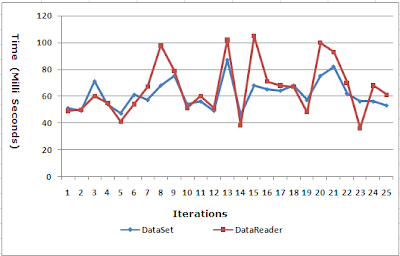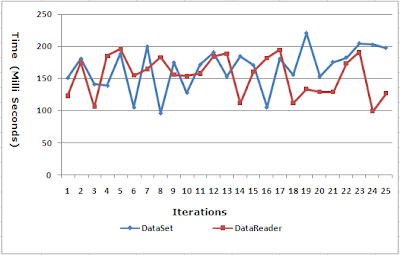In this post DataSet Vs DataReader
Performance Test – Loading a GridView we, shall compare the performance of DataSet
and DataReader in populating a GridView.
Asp.Net provides a number
of ways to fill a GridView, like DataReader, DataSet etc, each one has
its own advantages and disadvantages, we know that the DataReader is best
suited for forward only read operations and the DataSet is best suited for
offline data updates, we shall now see the difference in the loading time
between the two in action.
The configuration of the system used to
perform the evaluation is as follows.
|
OS
|
Windows XP Professional 2002 SP3
|
|
Processor
|
Pentium® D 2.66 GHz
|
|
RAM
|
3 GB
|
The performance test was carried out for 25
iterations with both DataSet and DataReader; the results of the test are
as follows.
Loading 1000 Records
DataSet Average time: 61.24
Milliseconds
DataReader Average time: 65.68 Milliseconds
DataReader Average time: 65.68 Milliseconds
Loading 2000 Records
DataSet Average time: 166.32
Milliseconds
DataReader Average time: 155.04 Milliseconds
DataReader Average time: 155.04 Milliseconds
Loading 3000 Records
DataSet Average time: 229.04
Milliseconds
DataReader Average time: 182.34 Milliseconds
DataReader Average time: 182.34 Milliseconds
Inference
Initially
for 1000 rows, it appeared that the DataSet was performing marginally better than
the DataReader, but as the number of rows increased to 2000 & later to 3000,
the DataReader performed considerably better than the DataSet, thus proving the
concept that the DataReader is best suited for ReadOnly forward only data.
The code used to perform the test is as
follows
DataSet
SqlConnection objConn;
SqlCommand objCmd;
SqlDataAdapter objDA;
DataSet dsEmployee;
Stopwatch timer;
string strQuery = string.Empty;
timer =
new Stopwatch();
timer.Start();
string strConn = ConfigurationManager.ConnectionStrings["EmployeesConnectionString"].ToString();
objConn
= new SqlConnection(strConn);
strQuery
= "SELECT * FROM Employee";
objCmd
= new SqlCommand(strQuery,
objConn);
objDA =
new SqlDataAdapter(objCmd);
dsEmployee
= new DataSet();
objDA.Fill(dsEmployee,
"dtEmployee");
grdEmployees.DataSource
= dsEmployee.Tables["dtEmployee"].DefaultView;
grdEmployees.DataBind();
timer.Stop();
lblExecutionTime.Text = "Execution
Time (Milliseconds):" + timer.ElapsedMilliseconds.ToString();
DataReader
SqlConnection objConn;
SqlCommand objCmd;
SqlDataReader objDR;
Stopwatch timer;
string strQuery = string.Empty;
timer =
new Stopwatch();
timer.Start();
string strConn = ConfigurationManager.ConnectionStrings["EmployeesConnectionString"].ToString();
objConn
= new SqlConnection(strConn);
strQuery
= "SELECT * FROM Employee";
objCmd
= new SqlCommand(strQuery,
objConn);
objConn.Open();
objDR =
objCmd.ExecuteReader();
grdEmployees.DataSource
= objDR;
grdEmployees.DataBind();
objConn.Close();
timer.Stop();
lblExecutionTime.Text = "Execution
Time (Milliseconds):" + timer.ElapsedMilliseconds.ToString();
That’s it we have seen the performance difference between
the DataSet and the DataReader in loading a GridView with data.







1 comment:
nice article Prakash.
Post a Comment